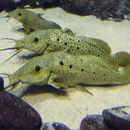fi
nimet breadcrumb-navigoinnissa


Auchenoglanis occidentalis és una espècie de peix de la família dels auquenoglanídids i de l'ordre dels siluriformes.
És omnívor: menja plàncton, mol·luscs, llavors i detritus.[8]
És un peix d'aigua dolça i de clima tropical (21°C-25°C).[5][9]
Es troba a la major part dels rius de l'Àfrica Occidental,[10] el llac Txad,[11] la conca sencera del riu Congo, el riu Nil,[12] els llacs de l'Àfrica Oriental i els rius Omo i Giuba.[5][13][14][15][16][17][18][19][20] [21]
Auchenoglanis occidentalis és una espècie de peix de la família dels auquenoglanídids i de l'ordre dels siluriformes.
Der Augenfleckwels (Auchenoglanis occidentalis) ist eine Welsart aus der Familie der Auchenoglanididae die im tropischen Afrika in Seen und großen Flüssen weit verbreitet ist.
Das Verbreitungsgebiet reicht in Nordostafrika vom ägyptischen Nil (im Süden bei Luxor und Assuan) über den Weißen und Blauen Nil im Sudan, dem Tekeze-Setit, Baro, Omo und Wabishebelle in Äthiopien bis zum Turkanasee und Juba. In Westafrika kommt er unter anderem im Senegal, Gambia, Casamance, Corubal, Géba, Sassandra, Bandama, Comoé, im Stromgebiet des Volta, im Niger und Ogun, im Einzugsgebiet des Tschadsee und im Cross River vor. Im äußersten Westen seines Verbreitungsgebietes lebt er sympatrisch mit Auchenoglanis biscutatus. Generell fehlt Auchenoglanis occidentalis in Gewässern die stark bewaldete Gebiete durchfließen. Trotzdem gibt es auch Vorkommen im Stromgebiet des Kongo. Die östlichsten Vorkommen befinden sich in einigen großen Seen Ostafrikas, im Albertsee und Edwardsee, sowie im Tanganjikasee und seinen Zuflüssen Rusizi und Malagarasi.[1]
Der Augenfleckwels wird maximal 70 cm lang. Der Wels hat einen mäßig gedrungenen Körper, der völlig schuppenlos ist. Die Schnauze ist spitz und von drei Bartelpaaren umgeben von denen das unterste am längsten ist und bis zum Rand des Kiemendeckels reicht. Rückenflosse und Brustflossen verfügen über kräftige Stachelstrahlen, die arretiert werden können. Die Fettflosse ist groß. Die Färbung des Augenfleckwels ist entsprechend dem großen Verbreitungsgebiet variabel und er ist bei beiger Grundfarbe entweder gleichmäßig mit eng stehenden dunklen Punkten oder großen, unregelmäßigen oder wabenförmigen braunen bis olivbraunen Flecken bedeckt, die durch helle, gitterartige Linien geteilt werden. Auch einfarbig dunkelbraune bis hell lilabraune Exemplare kommen vor. Die Unterseite ist weißlich-gelb.
Auchenoglanis occidentalis lebt in großen Seen und Flüssen vor allem in flachen Bereichen mit Schlammböden. Er ist ein Allesfresser und ernährt sich vor allem von Plankton, Weichtieren, Samen und Detritus. Die Eier werden in ein Nest gelegt und vom Männchen bewacht, nach dem Schlupf auch die Jungfische. Im Tanganjikasee legt der Kiemensackwels Dinotopterus cunningtoni seine Eier in die Nester des Augenfleckwels die dann von diesem bewacht und geschützt werden[2][3].
Der Augenfleckwels (Auchenoglanis occidentalis) ist eine Welsart aus der Familie der Auchenoglanididae die im tropischen Afrika in Seen und großen Flüssen weit verbreitet ist.
The giraffe catfish, Auchenoglanis occidentalis, is an African catfish. It eats plants off the floor of lakes and streams.
The giraffe catfish is found throughout Africa in lakes and rivers, partially due to introduction and establishment in other areas.[2] It is found in many important lakes and rivers such as the Nile and Lake Chad. Its distribution covers includes bodies of water from East Africa to West Africa. It generally lives in shallow waters with muddy bottoms.[1]
This fish has a maximum size that sources say are between two and three feet.
The giraffe-like pattern will fade with age to a two-tone mottled brown. Various subspecies have been described for this fish, indicating some geographical variation in coloration.[2]
Eggs are scattered in a nest and guarded by the male. Dinotopterus cunningtoni takes advantage of the care and allows the male giraffe catfish to care for its eggs and young, an example of interspecific brood care.[1]
The giraffe catfish is occasionally imported for the aquarium trade. Because of its large eventual size and its fast rate of growth, it is inappropriate for smaller aquaria. This fish will readily accept a variety of foods and is tolerant of a wide variety of water conditions. They will scavenge the aquarium looking for food, which could cause in the uprooting of plants.[2]
This fish is also an important food fish in Africa.[2]
The giraffe catfish, Auchenoglanis occidentalis, is an African catfish. It eats plants off the floor of lakes and streams.
Auchenoglanis occidentalis es una especie de peces de la familia Claroteidae en el orden de los Siluriformes.
• Los machos pueden llegar alcanzar los 70 cm de longitud total.[1][2]
Es ovíparo.
Es omnívoro: come plancton, moluscos, semillas y detritus.
Es un pez de agua dulce y de clima tropical. (21°C-25°C).
Se encuentra en la mayor parte de los ríos del África Occidental
Auchenoglanis occidentalis es una especie de peces de la familia Claroteidae en el orden de los Siluriformes.
Auchenoglanis occidentalis Auchenoglanis generoko animalia da. Arrainen barruko Claroteidae familian sailkatzen da.
Auchenoglanis occidentalis Auchenoglanis generoko animalia da. Arrainen barruko Claroteidae familian sailkatzen da.
Le Bagre ocellé (Auchenoglanis occidentalis) est une espèce de poissons-chats de la famille des Claroteidae originaire d'Afrique tropicale.
C'est un grand migrateur qui habite les zones peu profondes et vaseuses.
Omnivore.
La bouche est entourée de longs barbillons permettant de détecter la nourriture. Protactile, elle aspire la nourriture dans le sol et rejette le gravier nettoyé.
Le Bagre ocellé (Auchenoglanis occidentalis) est une espèce de poissons-chats de la famille des Claroteidae originaire d'Afrique tropicale.
Auchenoglanis occidentalis is een straalvinnige vissensoort uit de familie van de stekelmeervallen (Claroteidae).[1] De wetenschappelijke naam van de soort is voor het eerst geldig gepubliceerd in 1840 door Valenciennes.
Bronnen, noten en/of referenties西方項鱨(学名:Auchenoglanis occidentalis),為輻鰭魚綱鯰形目脂鱨科的其中一種,為熱帶淡水魚,分布於非洲尼羅河、盧阿拉巴河、剛果河、乍得湖、奧莫河與Giuba河流域,體長可達70公分,棲息在植被生長的泥底層水域,以軟體動物、昆蟲、魚類、植物等為食,生活習性不明,可做為食用魚。
西方項鱨(学名:Auchenoglanis occidentalis),為輻鰭魚綱鯰形目脂鱨科的其中一種,為熱帶淡水魚,分布於非洲尼羅河、盧阿拉巴河、剛果河、乍得湖、奧莫河與Giuba河流域,體長可達70公分,棲息在植被生長的泥底層水域,以軟體動物、昆蟲、魚類、植物等為食,生活習性不明,可做為食用魚。